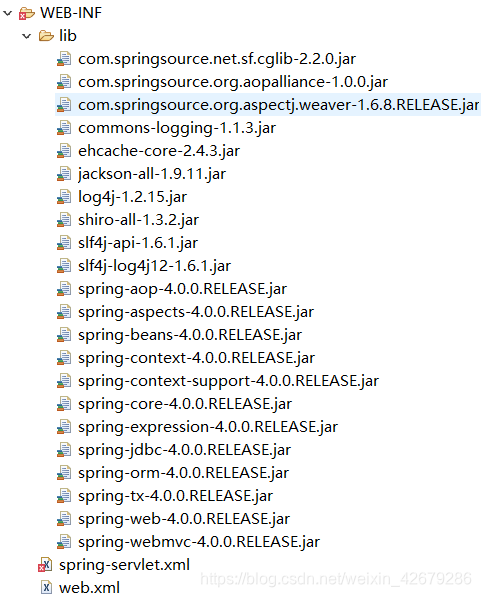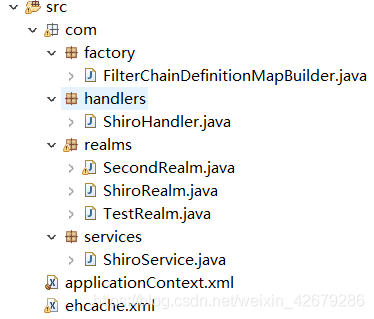创建web项目
1.配置在web.xml
<context-param>
<param-name>contextConfigLocation</param-name>
<param-value>classpath:applicationContext.xml</param-value>
</context-param>
<listener>
<listener-class>org.springframework.web.context.ContextLoaderListener</listener-class>
</listener>
<servlet>
<servlet-name>spring</servlet-name>
<servlet-class>org.springframework.web.servlet.DispatcherServlet</servlet-class>
<load-on-startup>1</load-on-startup>
</servlet>
<!-- 将所有请求映射到DispatcherServlet以进行处理 -->
<servlet-mapping>
<servlet-name>spring</servlet-name>
<url-pattern>/</url-pattern>
</servlet-mapping>
<!-- 拦截所有對象
1. 配置 Shiro 的 shiroFilter.
2. DelegatingFilterProxy 实际上是 Filter 的一个代理对象. 默认情况下, Spring 会到 IOC 容器中查找和
<filter-name> 对应的 filter bean. 也可以通过 targetBeanName 的初始化参数来配置 filter bean 的 id.
-->
<filter>
<filter-name>shiroFilter</filter-name>
<filter-class>org.springframework.web.filter.DelegatingFilterProxy</filter-class>
<init-param>
<param-name>targetFilterLifecycle</param-name>
<param-value>true</param-value>
</init-param>
</filter>
<filter-mapping>
<filter-name>shiroFilter</filter-name>
<url-pattern>/*</url-pattern>
</filter-mapping>
2.与web.xml相同路基下配置spring-servlet.xml
<beans xmlns="http://www.springframework.org/schema/beans"
xmlns:xsi="http://www.w3.org/2001/XMLSchema-instance"
xmlns:mvc="http://www.springframework.org/schema/mvc"
xmlns:context="http://www.springframework.org/schema/context"
xsi:schemaLocation="http://www.springframework.org/schema/mvc http://www.springframework.org/schema/mvc/spring-mvc-4.0.xsd
http://www.springframework.org/schema/beans http://www.springframework.org/schema/beans/spring-beans.xsd
http://www.springframework.org/schema/context http://www.springframework.org/schema/context/spring-context-4.0.xsd">
<context:component-scan base-package="com"></context:component-scan>
<bean class="org.springframework.web.servlet.view.InternalResourceViewResolver">
<property name="prefix" value="/"></property>
<property name="suffix" value=".jsp"></property>
</bean>
<mvc:annotation-driven></mvc:annotation-driven>
<mvc:default-servlet-handler/>
</beans>
3.在项目根路径下配置applicationContext.xml 和 ehcache.xml文件
applicationContext.xml文件
<?xml version="1.0" encoding="UTF-8"?>
<beans xmlns="http://www.springframework.org/schema/beans"
xmlns:xsi="http://www.w3.org/2001/XMLSchema-instance"
xsi:schemaLocation="http://www.springframework.org/schema/beans http://www.springframework.org/schema/beans/spring-beans.xsd">
<!-- 1. 配置 SecurityManager! -->
<bean id="securityManager" class="org.apache.shiro.web.mgt.DefaultWebSecurityManager">
<property name="cacheManager" ref="cacheManager"/>
<property name="authenticator" ref="authenticator"></property>
<property name="realms">
<list>
<ref bean="jdbcRealm"/>
<ref bean="secondRealm"/>
</list>
</property>
<property name="rememberMeManager.cookie.maxAge" value="10"></property>
</bean>
<!-- 让我们使用一些企业缓存支持来获得更好的性能。你可以用任何企业来代替它。
您喜欢的缓存框架实现(Terracotta+ehcache、Coherence、Gigaspace等) -->
<!--
2. 配置 CacheManager.
2.1 需要加入 ehcache 的 jar 包及配置文件.
-->
<bean id="cacheManager" class="org.apache.shiro.cache.ehcache.EhCacheManager">
<!-- 如果已经有net.sf.ehcache.cachemanager实例,请在此处设置一个。
如果没有,就换一个新的,默认配置创建:
<property name="cacheManager" ref="ehCacheManager"/> -->
<!-- 如果没有要插入的预构建net.sf.ehcache.cachemanager实例,但需要使用的特定ehcache配置,请在此处指定。
如果没有,默认的将被使用 -->
<property name="cacheManagerConfigFile" value="classpath:ehcache.xml"/>
</bean>
<!-- 配置认证策略 -->
<bean id="authenticator"
class="org.apache.shiro.authc.pam.ModularRealmAuthenticator">
<property name="authenticationStrategy">
<!-- 一个成功即可 -->
<bean class="org.apache.shiro.authc.pam.AtLeastOneSuccessfulStrategy"></bean>
<!-- 全部成功才通过 <bean class="org.apache.shiro.authc.pam.AllSuccessfulStrategy"></bean> -->
</property>
</bean>
<!-- 由SecurityManager用于访问安全数据(用户、角色等)。也可以使用许多其他领域实现propertiesrealm,LdapRealm等。 -->
<!--3. 配置 Realm
3.1 直接配置实现了 org.apache.shiro.realm.Realm 接口的 bean -->
<!-- 指定MD5加密 -->
<bean id="jdbcRealm" class="com.realms.ShiroRealm">
<property name="credentialsMatcher">
<bean class="org.apache.shiro.authc.credential.HashedCredentialsMatcher">
<property name="hashAlgorithmName" value="MD5"></property>
<property name="hashIterations" value="1024"></property>
</bean>
</property>
</bean>
<!-- SHA1加密 -->
<bean id="secondRealm" class="com.realms.SecondRealm">
<property name="credentialsMatcher">
<bean class="org.apache.shiro.authc.credential.HashedCredentialsMatcher">
<property name="hashAlgorithmName" value="SHA1"></property>
<property name="hashIterations" value="1024"></property>
</bean>
</property>
</bean>
<!--4. 配置 LifecycleBeanPostProcessor. 可以自定的来调用配置在 Spring IOC 容器中 shiro bean 的生命周期方法。-->
<bean id="lifecycleBeanPostProcessor" class="org.apache.shiro.spring.LifecycleBeanPostProcessor"/>
<!--5. 启用 IOC 容器中使用 shiro 的注解. 但必须在配置了 LifecycleBeanPostProcessor 之后才可以使用。-->
<bean class="org.springframework.aop.framework.autoproxy.DefaultAdvisorAutoProxyCreator"
depends-on="lifecycleBeanPostProcessor"/>
<bean class="org.apache.shiro.spring.security.interceptor.AuthorizationAttributeSourceAdvisor">
<property name="securityManager" ref="securityManager"/>
</bean>
<!-- 在这里定义shiro过滤器(作为factrybean),而不是直接在web.xml中定义-web.xml使用delegingfilterproxy访问这个bean。-->
<!--
6. 配置 ShiroFilter.
6.1 id 必须和 web.xml 文件中配置的 DelegatingFilterProxy 的 <filter-name> 一致.
若不一致, 则会抛出: NoSuchBeanDefinitionException. 因为 Shiro 会来 IOC 容器中查找和 <filter-name> 名字对应的 filter bean.
-->
<bean id="shiroFilter" class="org.apache.shiro.spring.web.ShiroFilterFactoryBean">
<property name="securityManager" ref="securityManager"/>
<property name="loginUrl" value="/login.jsp"/>
<property name="successUrl" value="/list.jsp"/>
<property name="unauthorizedUrl" value="/unauthorized.jsp"/>
<property name="filterChainDefinitionMap" ref="filterChainDefinitionMap"></property>
<!--
配置哪些页面需要受保护.
以及访问这些页面需要的权限.
1). anon 可以被匿名访问
2). authc 必须认证(即登录)后才可能访问的页面.
3). logout 登出.
4). roles 角色过滤器
-->
<!--
<property name="filterChainDefinitions">
<value>
/login.jsp = anon
/shiro/login = anon
/shiro/logout = logout
/user.jsp = roles[user]
/admin.jsp = roles[admin]
# everything else requires authentication:
/** = authc
</value>
</property>
-->
</bean>
<!-- 配置一个 bean, 该 bean 实际上是一个 Map. 通过实例工厂方法的方式 -->
<bean id="filterChainDefinitionMap"
factory-bean="filterChainDefinitionMapBuilder" factory-method="buildFilterChainDefinitionMap"></bean>
<bean id="filterChainDefinitionMapBuilder"
class="com.factory.FilterChainDefinitionMapBuilder"></bean>
<!-- 注解设置权限 -->
<bean id="shiroService" class="com.services.ShiroService"></bean>
</beans>
ehcache.xml文件
<ehcache>
<!-- 设置创建cache.data文件的目录的路径。
如果路径是Java系统属性,则替换为它在正在运行的虚拟机中的值。
转换以下属性:
user.home-用户的主目录
user.dir-用户的当前工作目录
java.io.tmpdir-默认临时文件路径 -->
<diskStore path="java.io.tmpdir"/>
<cache name="authorizationCache"
eternal="false"
timeToIdleSeconds="3600"
timeToLiveSeconds="0"
overflowToDisk="false"
statistics="true">
</cache>
<cache name="authenticationCache"
eternal="false"
timeToIdleSeconds="3600"
timeToLiveSeconds="0"
overflowToDisk="false"
statistics="true">
</cache>
<cache name="shiro-activeSessionCache"
eternal="false"
timeToIdleSeconds="3600"
timeToLiveSeconds="0"
overflowToDisk="false"
statistics="true">
</cache>
<!--
默认缓存需要以下属性:
maximemory-设置将在内存中创建的最大对象数 ,永恒-设定元素是否永恒。如果是永恒的,则忽略超时和元素 ,永不过期。
TimeToIdleSeconds-设置元素在过期之前的空闲时间。仅用于 ,如果元素不是永恒的。空闲时间现在是-上次访问时间
TimeToLiveSeconds-设置元素在过期之前的生存时间。仅用于如果元素不是永恒的。TTL现在是-创建时间
overflowTodisk-设置在内存缓存中元素是否可以溢出到磁盘 已达到最大内存限制。 -->
<defaultCache
maxElementsInMemory="10000"
eternal="false"
timeToIdleSeconds="120"
timeToLiveSeconds="120"
overflowToDisk="true"
/>
<!--预定义的缓存。在此处添加缓存配置设置。
如果您没有缓存的配置,当缓存管理器启动
默认缓存需要以下属性:
name-设置缓存的名称。这用于标识缓存。它必须是独一无二的。
maximemory-设置将在内存中创建的最大对象数
eternal-设定元素是否永恒。如果是永恒的,则忽略超时和元素永不过期。
TimeToIdleSeconds-设置元素在过期之前的空闲时间。仅用于如果元素不是永恒的。空闲时间现在是-上次访问时间
TimeToLiveSeconds-设置元素在过期之前的生存时间。仅用于如果元素不是永恒的。TTL is now-创建时间
overflowTodisk-设置在内存缓存中元素是否可以溢出到磁盘已达到最大内存限制。-->
<!-- 名为samplecache1的示例缓存,此缓存最多包含10000个元素的内存,将过期闲置时间超过5分钟且寿命超过10分钟。
如果元素超过10000个,它将溢出到磁盘缓存,在这个配置中,它将转到java.io.tmp所在的任何位置。 -->
<cache name="sampleCache1"
maxElementsInMemory="10000"
eternal="false"
timeToIdleSeconds="300"
timeToLiveSeconds="600"
overflowToDisk="true"
/>
<!-- 名为samplecache2的示例缓存,此缓存包含1000个元素。元素将始终保存在内存中。它们没有过期。 -->
<cache name="sampleCache2"
maxElementsInMemory="1000"
eternal="true"
timeToIdleSeconds="0"
timeToLiveSeconds="0"
overflowToDisk="false"
/> -->
</ehcache>
4.在lib下加入相应架包

5.根路径下穿件com文件夹并创相应文件

ShiroHandler
@Controller
@RequestMapping("/shiro")
public class ShiroHandler {
@Autowired
private ShiroService shiroService;
@RequestMapping("/testShiroAnnotation")
public String testShiroAnnotation(HttpSession session){
session.setAttribute("key", "value12345");
shiroService.testMethod();
return "redirect:/list.jsp";
}
@RequestMapping("/login")
public String login(@RequestParam("username") String username,
@RequestParam("password") String password){
Subject currentUser = SecurityUtils.getSubject();
//调动 Subject 的 isAuthenticated()测试当前的用户是否已经被认证,即是否已经登录。
if (!currentUser.isAuthenticated()) {
// 把用户名和密码封装为 UsernamePasswordToken 对象
UsernamePasswordToken token = new UsernamePasswordToken(username, password);
// rememberme
token.setRememberMe(true);
try {
System.out.println("1. " + token.hashCode());
// 执行登录。
currentUser.login(token);
}
// ... catch more exceptions here (maybe custom ones specific to your application?
// 所有认证时异常的父类.
catch (AuthenticationException ae) {
//unexpected condition? error?
System.out.println("登录失败: " + ae.getMessage());
}
}
//重定向
return "redirect:/list.jsp";
}
}
ShiroRealm
@Override
protected AuthenticationInfo doGetAuthenticationInfo(
AuthenticationToken token) throws AuthenticationException {
System.out.println("[FirstRealm] doGetAuthenticationInfo");
//1. 把 AuthenticationToken 转换为 UsernamePasswordToken
UsernamePasswordToken upToken = (UsernamePasswordToken) token;
//2. 从 UsernamePasswordToken 中来获取 username
String username = upToken.getUsername();
char[] password = upToken.getPassword();
//3. 调用数据库的方法, 从数据库中查询 username 对应的用户记录
System.out.println("从数据库中获取 username: " + username + " 所对应的用户信息.1");
System.out.println("从数据库中获取 password: " + password.toString() + " 所对应的用户信息.1");
//4. 若用户不存在, 则可以抛出 UnknownAccountException 异常
if("unknown".equals(username)){
System.out.println("*******用户不存在!1");
throw new UnknownAccountException("用户不存在!1");
}
//5. 根据用户信息的情况, 决定是否需要抛出其他的 AuthenticationException 异常.
if("monster".equals(username)){
System.out.println("*************用户被锁定1");
throw new LockedAccountException("用户被锁定1");
}
//6. 根据用户的情况, 来构建 AuthenticationInfo 对象并返回. 通常使用的实现类为: SimpleAuthenticationInfo
//以下信息是从数据库中获取的.
//1). principal: 认证的实体信息. 可以是 username, 也可以是数据表对应的用户的实体类对象.
Object principal = username;
//2). credentials: 密码.
Object credentials = "098d2c478e9c11555ce2823231e02ec1"; //"fc1709d0a95a6be30bc5926fdb7f22f4";
if("admin".equals(username)){
credentials = "038bdaf98f2037b31f1e75b5b4c9b26e";
}else if("user".equals(username)){
credentials = "098d2c478e9c11555ce2823231e02ec1";
}
//3). realmName: 当前 realm 对象的 name. 调用父类的 getName() 方法即可
String realmName = getName();
//4). 盐值.
ByteSource credentialsSalt = ByteSource.Util.bytes(username);
SimpleAuthenticationInfo info = null;
info = new SimpleAuthenticationInfo(principal, credentials, credentialsSalt, realmName);
return info;
}
public static void main(String[] args) {
String hashAlgorithmName = "MD5";
Object credentials = "123456";
Object salt = ByteSource.Util.bytes("user");;
int hashIterations = 1024;
Object result = new SimpleHash(hashAlgorithmName, credentials, salt, hashIterations);
System.out.println(result);
}
//授权会被 shiro 回调的方法
@Override
protected AuthorizationInfo doGetAuthorizationInfo(
PrincipalCollection principals) {
//1. 从 PrincipalCollection 中来获取登录用户的信息
Object principal = principals.getPrimaryPrincipal();
//2. 利用登录的用户的信息来用户当前用户的角色或权限(可能需要查询数据库)
Set<String> roles = new HashSet<>();
roles.add("user");
if("admin".equals(principal)){
roles.add("admin");
}
//3. 创建 SimpleAuthorizationInfo, 并设置其 reles 属性.
SimpleAuthorizationInfo info = new SimpleAuthorizationInfo(roles);
//4. 返回 SimpleAuthorizationInfo 对象.
return info;
}
}
SecondRealm
package com.realms;
import org.apache.shiro.authc.AuthenticationException;
import org.apache.shiro.authc.AuthenticationInfo;
import org.apache.shiro.authc.AuthenticationToken;
import org.apache.shiro.authc.LockedAccountException;
import org.apache.shiro.authc.SimpleAuthenticationInfo;
import org.apache.shiro.authc.UnknownAccountException;
import org.apache.shiro.authc.UsernamePasswordToken;
import org.apache.shiro.crypto.hash.SimpleHash;
import org.apache.shiro.realm.AuthenticatingRealm;
import org.apache.shiro.util.ByteSource;
public class SecondRealm extends AuthenticatingRealm {
@Override
protected AuthenticationInfo doGetAuthenticationInfo(
AuthenticationToken token) throws AuthenticationException {
System.out.println("[SecondReaml] doGetAuthenticationInfo");
//1. 把 AuthenticationToken 转换为 UsernamePasswordToken
UsernamePasswordToken upToken = (UsernamePasswordToken) token;
//2. 从 UsernamePasswordToken 中来获取 username
String username = upToken.getUsername();
//3. 调用数据库的方法, 从数据库中查询 username 对应的用户记录
System.out.println("从数据库中获取 username2: " + username + " 所对应的用户信息.2");
//4. 若用户不存在, 则可以抛出 UnknownAccountException 异常
if("unknown".equals(username)){
throw new UnknownAccountException("用户不存在2!");
}
//5. 根据用户信息的情况, 决定是否需要抛出其他的 AuthenticationException 异常.
if("monster".equals(username)){
throw new LockedAccountException("用户被锁定2");
}
//6. 根据用户的情况, 来构建 AuthenticationInfo 对象并返回. 通常使用的实现类为: SimpleAuthenticationInfo
//以下信息是从数据库中获取的.
//1). principal: 认证的实体信息. 可以是 username, 也可以是数据表对应的用户的实体类对象.
Object principal = username;
//2). credentials: 密码.
Object credentials = "098d2c478e9c11555ce2823231e02ec1"; //"fc1709d0a95a6be30bc5926fdb7f22f4";
if("admin".equals(username)){
credentials = "ce2f6417c7e1d32c1d81a797ee0b499f87c5de06";
}else if("user".equals(username)){
credentials = "073d4c3ae812935f23cb3f2a71943f49e082a718";
}
//3). realmName: 当前 realm 对象的 name. 调用父类的 getName() 方法即可
String realmName = getName();
//4). 盐值.
ByteSource credentialsSalt = ByteSource.Util.bytes(username);
SimpleAuthenticationInfo info = null; //new SimpleAuthenticationInfo(principal, credentials, realmName);
info = new SimpleAuthenticationInfo("secondRealmName", credentials, credentialsSalt, realmName);
return info;
}
public static void main(String[] args) {
String hashAlgorithmName = "SHA1";
Object credentials = "123456";
Object salt = ByteSource.Util.bytes("admin");;
int hashIterations = 1024;
Object result = new SimpleHash(hashAlgorithmName, credentials, salt, hashIterations);
System.out.println(result);
}
}
TestRealm
public class TestRealm extends AuthorizingRealm {
//用于授权的方法.
@Override
protected AuthorizationInfo doGetAuthorizationInfo(
PrincipalCollection principals) {
// TODO Auto-generated method stub
return null;
}
//用于认证的方法
@Override
protected AuthenticationInfo doGetAuthenticationInfo(
AuthenticationToken token) throws AuthenticationException {
// TODO Auto-generated method stub
return null;
}
}
FilterChainDefinitionMapBuilder
public class FilterChainDefinitionMapBuilder {
public LinkedHashMap<String, String> buildFilterChainDefinitionMap(){
LinkedHashMap<String, String> map = new LinkedHashMap<>();
map.put("/login.jsp", "anon");
map.put("/shiro/login", "anon");
map.put("/shiro/logout", "logout");
map.put("/user.jsp", "authc,roles[user]");
map.put("/admin.jsp", "authc,roles[admin]");
map.put("/list.jsp", "user");
map.put("/**", "authc");
return map;
}
}






















 563
563

 被折叠的 条评论
为什么被折叠?
被折叠的 条评论
为什么被折叠?








